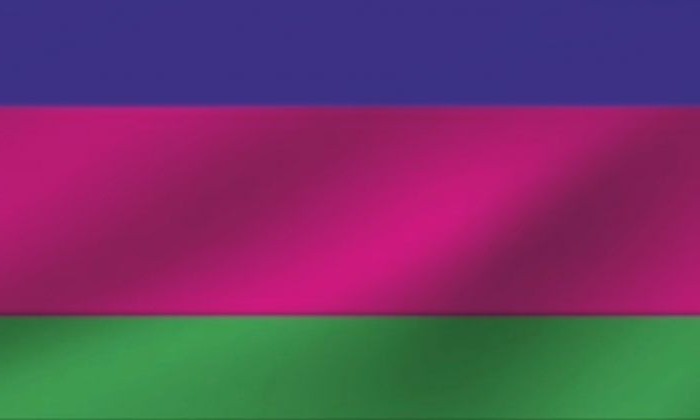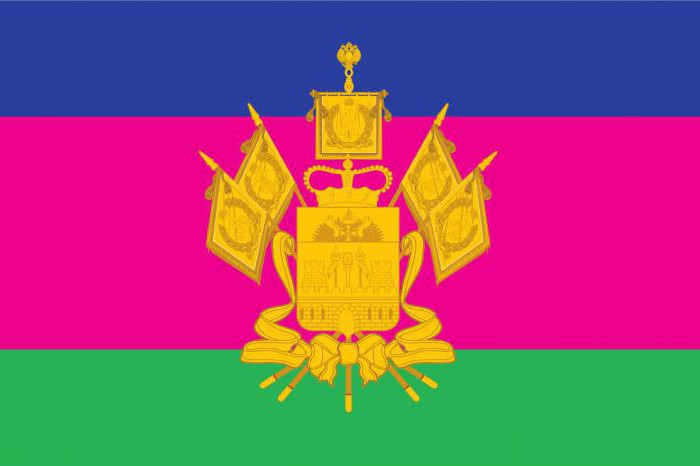The history of the Kuban, the Kuban Cossacks today causes controversy both among historians and among the bearers of this unique culture. There is no unity in the interpretation of symbols and attributes, such as the Kuban flag.
The tricolor, which became the official state symbol of the Krasnodar Territory, was created on the basis of the historical flag of the Kuban Cossack army, but there is no clear and unambiguous explanation of the symbolic meaning of its colors.
Kuban region
The region of southern Russia, named after the largest river in the North Caucasus, includes territories belonging to several constituent entities of the Russian Federation: most of the Krasnodar Territory, the entire Republic of Adygea and a significant part of Karachay-Cherkessia, the western regions of the Stavropol Territory and a small part of the south of the Rostov Region.
The capital of the region is considered to be Krasnodar - the administrative center of the region of the same name. The emblem of the Krasnodar Territory has historical roots associated with the Kuban Cossacks, and the flag of the region, approved in 1995, is the unofficial flag of the Kuban. It is based on the flag of the Kuban Cossacks with a cloth of three horizontal stripes, the middle of which - raspberry - was twice as wide as the other two: the upper - blue, and the lower - green.
The meaning of the flowers and their arrangement have never been documented. There are several options that are associated with the existence of several ethnic groups that make up the Kuban Cossacks.
Black Sea Cossacks
The legendary Zaporizhzhya Sich is considered one of the sources of the Cossacks. Since the XVI century, the military prowess of the Cossacks was used for their purposes by the rulers of many states of southern Europe, including Russian tsars. But he was not destined to completely subjugate the Cossack freemen to himself. Cossacks were considered a threat to trade caravans passing near their settlements; wealthy landowners throughout the district suffered from their raids. But the main thing that the Russian Empress Catherine II could not forgive for them was support for peasant uprisings, especially participation in the Pugachev riot. As a result, she ordered to pacify the Zaporizhzhya Cossacks.
The process of liquidation of the Cossacks, which was led by Grigory Potemkin, soon gave way to the use of Cossack military units in the Russian-Turkish war. For their valor, Cossacks were granted land in territories conquered from the Turks along the Black Sea coast, and their settlements were called the “Black Sea Cossack Army”. In 1792, the Black Sea Cossacks were allocated to the eternal and hereditary possession of land in the Kuban. The Black Sea Cossacks, descendants of the Cossacks, made up the bulk of the Kuban Cossacks, and, according to one version, it is they who are embodied in the crimson color that the flag of the Kuban contains in the central part.
Linear Cossacks
The history of the linear Cossack army begins with the formation of a united front from strong points located along the Terek River. This front was supposed to confront the highlanders of the Caucasus. The Caucasian line was made up of villages that were populated by immigrants from the Terek, Volga and Little Russian Cossacks, as well as from the same class as service people who served to protect the southern borders of the Kursk, Oryol and Voronezh provinces.
In the 1780s, when the formation of the Kuban regiment began, it included line-ups from the Caucasian army, as well as part of the Don and Azov Cossacks. A Black Sea cordon line was formed along the right bank of the Kuban to the coast. The purpose of its creation was to protect against raids of the peoples that previously owned the lands of the Kuban region - Circassians, Adyghe, and others.
Cossacks-linearists, according to one version, symbolized the blue color that the Kuban flag contained in the upper part.
Ascribed foreigners
In the second half of the 19th century, state peasants from central Russia and retired soldiers enlisted in the Cossacks began to settle in the Kuban. Among the immigrants there were many cantonists - minors assigned to the military department by birth (children of soldiers, Jews, schismatics, rebels from Poland), as well as juvenile orphans, vagabonds, gypsies, etc. They either settled in the existing villages, or formed separate settlements.
According to the main version, the immigrants-foreigners attributed to the Cossacks are a symbolic justification of the green color of the Kuban flag. According to another, it symbolizes the Muslim peoples that made up the original, "indigenous" (local), indigenous population of the Kuban. These include mainly Circassians, Circassians and other highlanders.
Roots, trunk, branches
The most popular explanation of the symbolism of the Kuban Cossack flag, including the location of the stripes that make up the Kuban flag, the meaning of colors - finds an image that explains the relationship of its components in the form of a tree.
The state-forming, fundamental importance of the Black Sea Cossacks, or according to another version - the entire Cossack population of the Kuban region, is emphasized by the central location and doubled strip of crimson color. According to the terminology used in this explanation of the symbols of the Kuban Cossack flag, this is the “trunk” that forms the entire population of the Kuban.
"Roots" - the population of Muslim peoples who previously lived in the Kuban, they are personified by a green stripe located below. “Branches” are all peoples who arrived here after those who originally lived there, who settled in the Kuban after the formation of the Kuban Cossack army began. All this "tree", symbolizing the population of the region, can live, like a real plant, only in the complete interconnection of all its parts.
Kuban People's Republic of 1918
After October 1917, a dramatic page began in the history of the Cossacks, including its Kuban part. It did not escape what constituted the essence of the main tragedy of the civil war - the rift that affected peoples, villages and individual families. It is believed that the Cossacks for the most part hostilely accepted Soviet power, so in 1917 the Kuban Council was created, at the beginning of 1918 proclaiming the independent Kuban People’s Republic.

This state formation lasted until the spring of 1920, becoming a victim of confrontation not only with the Red Army, but also with the Denikin Volunteer Army. But the main reason that the history of the Cossack republic in the Kuban was short-lived was the disagreement in its leadership. Given the unity of the hostile attitude towards Bolshevism, the leaders of the Kuban Cossacks were divided into supporters of a different path of the PRC. Some offered to join Ukraine, others relied on the help of foreign armies, others suggested a struggle for a great Russia to a victorious end as part of the White Guard troops.
At one time, the question of the entry of the Kuban People's Republic into the League of Nations was seriously considered. The republic also had the heraldic attributes of this state - the flag, the coat of arms of the Kuban. The blue-raspberry-green tricolor has since become an unwritten symbol of the Kuban Cossacks. It became the basis of modern official symbols.
Flag of Krasnodar Territory
Since autumn 2004, the flag of the Krasnodar Territory has been entered in the State Heraldry Register of the Russian Federation under the number 1503. Under the previous number, the coat of arms of the Krasnodar Territory is also included there. It symbolizes one of the sections of the Caucasian line of military fortifications, created at the direction of the Russian emperors from Catherine to Alexander II, its right flank. In the one-color (gold with an orange outline) version, it occupies a central place on the flag of the Kuban.

The flag of the Krasnodar Territory was approved in 1995. Three horizontal stripes of different sizes — a raspberry broad in the middle, blue on the top, and green below — migrated from the official symbol of the PRC during the Civil War to the flag of the Krasnodar Territory — the flag of the Kuban. A photo of the Legislative Assembly of the Krasnodar Territory with the flag raised for the first time on June 1, 1995, has become a symbol of the continuity of the traditions of the Kuban Cossacks. In 2004, the coat of arms of the Kuban was slightly changed (the ribbon of the Order of Lenin and the princely crown were added), which was reflected in the flag of the region.
The revival of Kuban symbolism
The very first attempts to revive the Cossacks were made even before the official fall of the USSR. In October 1990, the Kuban Cossack Council was established in Krasnodar, then a congress was held to establish the Kuban Military Cossack Society, and its symbols, including the blue-raspberry-green tricolor - the flag of the Kuban. The photos of the participants of the Constituent All-Cuban Cossack Congress became one of the very first examples of official publication after a long break of the historical flag of the Kuban Cossack army.
The qualitative composition of modern Cossacks is heterogeneous, although for most faithful heirs to traditions, the symbols of the glory of their ancestors are not just pictures. The flag of the Kuban - Cossack tricolor - the embodiment of the unity of the peoples inhabiting the region, glorious history and hope for a better future.